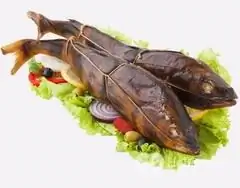- Author Rachel Wainwright [email protected].
- Public 2023-12-15 07:39.
- Last modified 2025-11-02 20:14.
Terpug
Terpug is a sea fish from the Terpugov family, the Scorpion-like order. Other names for this fish are sea lenok, perch, greenling. Like other Terpugovye, these fish are found in schools, they prefer to choose bottom territories for habitation. The average length of an adult greenling is 40-50 cm, weight is about one and a half kilograms. Many marine mammals feed on terpugs.
The ratio of BZHU in the product

Source: daryrossii.ru How to burn 102 kcal?
| Walking | 26 minutes |
| Jogging | 11 minutes |
| Swimming | 9 minutes |
| A bike | 15 minutes. |
| Aerobics | 20 minutes. |
| Household chores | 34 minutes |
The appearance of this fish is characteristic - the shape of the body is flattened from the sides, the scales are small, forming wide vertical light and dark stripes. The fin on the back of the fish is gray, solid, with a black border, one or two feathers. Depending on the variety of the greenling, the number of lateral lines along the body ranges from 1 to 5. Greenplants breed in winter, in shallow water, in fast-flowing water. Their caviar is sticky, it sticks to stones. Until the fry emerge, males guard the laid eggs.
The following subspecies of rasp are found:
- Single line;
- Harehead;
- Brown;
- Japanese;
- Spotted;
- Browed.
Each subspecies has its own morphological characteristics and habitats. Greenplants live in the seas of the Far East, on the coast of Kamchatka, near the Bering Sea. On an industrial scale, this fish is caught using bottom trawls and seines. Amateur fishing is carried out with a line or with a line.
Eating a rasp
Thanks to the tasty and healthy meat, the rasp is a valuable commercial object. The fish goes on sale frozen, closer to fishing grounds - chilled. Fresh raspberry meat has a greenish or yellowish tint, which sometimes alarms the consumer.
There are many different ways to cook this fish. All cooking recipes are pretty simple. You can cook fish soup from the rasp, fry it, salt, pickle, smoke. Rasp meat is added to salads. The fishing industry produces canned food made from rasp. The advantages of this fish include the fact that it has few bones and is easy to clean before cooking.

The rasp turns out to be very tasty and nutritious if it is smoked. Frozen fish is most often used to smoke the greenling. Before cooking, the fish is rubbed with salt and spices. When hot-smoked, the greenling leaves its meat juicy and aromatic. This option is suitable for adding to salads, as well as an independent snack. As a dietary food, the rasp can be baked, steamed, or using an airfryer.
Useful properties of rasp
Greenery meat is a source of protein and essential amino acids for humans. The beneficial properties of raspberry are also determined by the content of unsaturated omega-3 fatty acids. It is known that they prevent the appearance of atherosclerotic plaques on the walls of blood vessels, improve the activity of the cardiovascular system. The regular use of the rasp has a positive effect on the state of the nervous system.
This fish contains vitamins A, C, PP, group B and microelements molybdenum, chromium, sulfur, iron, bromine, etc. The beneficial properties of the rasp directly depend on them. If the thyroid gland is inadequate, the rag meat will become a natural source of iodine.
The calorie content of rasp is about 102 kcal per 100 g of product, and varies depending on the cooking method. Due to the average values of the calorie content of green grass, it can be used by people who monitor their weight.
The harm of the rasp
As a sea fish, the greenling sometimes can cause an individual intolerance, which manifests itself in allergic reactions. Oven-cooked rasp is not recommended for people with peptic ulcer and kidney disease.
YouTube video related to the article:
Found a mistake in the text? Select it and press Ctrl + Enter.






